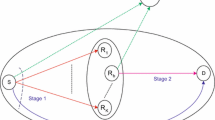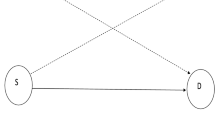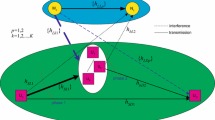Abstract
For cognitive relay networks (CRNs) where the secondary link contains multiple relays, considering the interference from primary user (PU) and the maximum transmit power constraint at the secondary user, we investigate the exact and asymptotic outage probabilities for both proactive and reactive decode-and-forward (DF) schemes. Unlike the conventional opportunistic relay networks where the outage probabilities for both proactive and reactive DF schemes are the same, it is found that an outage gap of the two schemes does exist for the CRNs. It is shown that the outage gap tends to zero when the interference caused by PU is high enough and the outage gap increases with the increase of the difference between the threshold signal-to-interference-and-noise ratios at relay and destination.



Similar content being viewed by others
References
Haykin, S. (2005). Cognitive radio: Brain-empowered wireless communications. IEEE Journal on Selected Areas in Communications, 23(2), 201–220.
Zhao, Q., & Sadler, B. M. (2007). A survey of dynamic spectrum access. IEEE Signal Processing Magazine, 24(3), 79–89.
Farraj, A. K., Hammad, E. M. (2012). Impact of quality of service constraints on the performance of spectrum sharing cognitive users. Wireless Personal Communications, 1–16, doi:10.1007/s11277-012-0606-6 (Published Online).
Farraj, A. K., & Ekin, S. (2013). Performance of cognitive radios in dynamic fading channels under primary outage constraint. Wireless Personal Communications, 73(3), 637–649.
Li, D. (2012). Joint power and rate control combined with adaptive modulation in cognitive radio networks. Wireless Personal Communications, 63(3), 0929–6212.
Yang, L., Qaraqe, K. A., Serpedin, E., & Alouini, M. S. (2013). Performance analysis of distributed beamforming in a spectrum sharing system. IEEE Transactions on Vehicular Technology, 62(4), 1655–1666.
Laneman, J. N., Tse, D. N. C., & Wornell, G. W. (2004). Cooperative diversity in wireless networks: Efficient protocols and outage behavior. IEEE Transactions on Information Theory, 50(12), 3062–3080.
Zhang, Q., Jia, J., & Zhang, J. (2009). Cooperative relay to improve diversity in cognitive radio networks. IEEE Communications Magazine, 47(2), 111–117.
Guo, Y., Kang, G., Zhang, N., Zhou, W., & Zhang, P. (2010). Outage performance of relay-assisted cognitive-radio system under spectrum-sharing constraints. Electronics Letters, 46(2), 182–184.
Luo, L., Zhang, P., Zhang, G., & Qin, J. (2011). Outage performance for cognitive relay networks with underlay spectrum sharing. IEEE Communications Letters, 15(7), 710–712.
Yan, Z., Zhang, X., & Wang, W. (2011). Exact outage performance of cognitive relay networks with maximum transmit power limits. IEEE Communications Letters, 15(12), 1317–1319.
Yang, P., Luo, L., & Qin, J. (2012). Outage performance of cognitive relay networks with interference from primary user. IEEE Communications Letters, 16(10), 1695–1698.
Xu, W., Zhang, J., Zhang, P., & Tellambura, C. (2012). Outage probability of decode-and-forward cognitive relay in presence of primary user’s interference. IEEE Communications Letters, 16(8), 1252–1255.
Xia, M., & Aissa, S. (2012). Cooperative AF relaying in spectrum-sharing systems: Outage probability analysis under co-channel interferences and relay selection. IEEE Transactions on Communications, 60(11), 3252–3262.
Yang, P., Zhang, Q., Luo, L., & Qin, J. (2014). Outage performance of underlay cognitive opportunistic multi-relay networks in the presence of interference from primary user. Wireless Personal Communications, 74(2), 343–358.
Si, J., Li, Z., Huang, H., Chen, J., & Gao, R. (2012). Capacity analysis of cognitive relay networks with the PU’s interference. IEEE Communications Letters, 16(12), 2020–2023.
Bletsas, A., Shin, H., & Win, M. Z. (2007). Cooperative communications with outage-optimal opportunistic relaying. IEEE Transactions on Wireless Communications, 6(9), 3450–3460.
Forney, G. D., & Forney, G. D. (1966). Concatenated codes (Vol. 11). Cambridge: MIT press.
Gradshteyn, I. S., & Ryzhik, I. M. (2007). Table of integrals, series, and products (7th ed.). Waltham: Academic.
Prudnikov, A. P., Brychkov, Y. A., & Marichev, O. I. (1986). Integrals and series: Elementary functions (Vol. 1). Amsterdam: Gordon Breach Science Publishers.
Acknowledgments
This work was supported by the National Natural Science Foundation of China (61173148, 61102070, and 61202498), the Industry-University-Research Project of Guangdong Province and the Ministry of Education, China (2011B090400581), the Natural Science Foundation of Guangdong Province (S2011040004135), the Scientific and Technological Project of Guangzhou City (12C42051578 and 11A11060133), and Guangxi Natural Science Foundation (2012GXNSFBA053162), the Research Fund for the Doctoral Program of Dongguan University of Technology (ZJ20131205).
Author information
Authors and Affiliations
Corresponding author
Appendices
Appendix 1: Proof of Proposition 1
In (6), the CDF of \(\text{ F }_{\gamma _{s {r_k}}|g_{sp}}(\gamma _{th}^{\mathrm{R}})\) can be expressed as
where \(\varOmega =\{(x,y)|0<x< \infty , 0<y<\frac{\gamma _{th}^{\mathrm{R}}(\gamma _I x+1)}{\min \{\gamma /g_{sp}, \gamma _{Q}\}}\}\) is the integration region; \(f_{X, Y}(\bullet )\) denotes the joint probability density function (PDF) of \(X\) and \(Y\).
Given \(g_{sp}\), both \(g_{s {r_k}}\) and \(g_{cr_k}\) are exponential RVs in (6). The joint PDF of \(g_{c r_k}\) and \(g_{s r_k}\) is expressed as
Thus, we have
where
Applying the binomial theorem, we have
Since the PDF of \(g_{sp}\) is expressed as
we have
Since \(\min \{\gamma /g_{sp}, \gamma _{Q}\}=\gamma _{Q}\) if \(g_{sp}<\gamma /\gamma _{Q}\) and \(\min \{\gamma /g_{sp}, \gamma _{Q}\}=\gamma /g_{sp}\) if \(g_{sp}\ge \gamma /\gamma _{Q}\), we divide the interval \([0, \infty )\) into two intervals, \([0, \gamma /\gamma _{Q})\) and \([\gamma /\gamma _{Q}, \infty )\). We do the integration over the two intervals respectively. Applying the identity [19, Eq. (3.462.16)], the final result is obtained.
Appendix 2: Proof of Proposition 2
In (7), the CDF of \(\text{ F }_{\gamma _{{r_k}d}|g_{cd}}(\gamma _{th}^{\mathrm{D}})\) is obtained as
Given \(g_{cd}\), both \(g_{{r_k}d}\) and \(g_{{r_k}p}\) are exponential RVs in (7). The PDF of \(g_{r_kj}\), \(j\in \{d, p\}\), is expressed as
Since \(\min \{\gamma /g_{r_kp}, \gamma _{Q}\}=\gamma _{Q}\) if \(g_{r_kp}<\gamma /\gamma _{Q}\) and \(\min \{\gamma /g_{r_k p}, \gamma _{Q}\}=\gamma /g_{r_k p}\) if \(g_{r_kp}\ge \gamma /\gamma _{Q}\), we have
where
Thus, we have
where the second equation is obtained by applying the binomial theorem for three times. Since the PDF of \(g_{cd}\) is
we have
Substituting (35) into (37) and after some mathematical manipulations, the final result is obtained.
Appendix 3: Proof of Theorem 1
Reformulate (5) as follows
where
From the binomial theorem, we have
Employing the binomial theorem, (40) is expressed as
The function \(\text{ F }_{\gamma _{s {r_k}}|g_{sp}}(x)\) is monotonically increasing with respect to \(x\). Thus, we obtain the OP relationship of the proactive and reactive DF schemes.
Appendix 4: Proof of Corollary 2
We differentiate \(\text{ F }_{\gamma _{s{r_k}}|g_{sp}}(\gamma _{th}^{\mathrm{R}})\) with respect to \(\gamma _{th}^{\mathrm{R}}\),
Thus, we have
From (40), we know
According to (42), the outage gap can be rewritten as
Now, the gradient of outage gap is given as
The final result is obtained.
Rights and permissions
About this article
Cite this article
Yang, P., Song, J., Li, M. et al. Outage Probability Gap Between Proactive and Reactive Opportunistic Cognitive Relay Networks. Wireless Pers Commun 82, 2417–2429 (2015). https://doi.org/10.1007/s11277-015-2356-8
Published:
Issue Date:
DOI: https://doi.org/10.1007/s11277-015-2356-8




